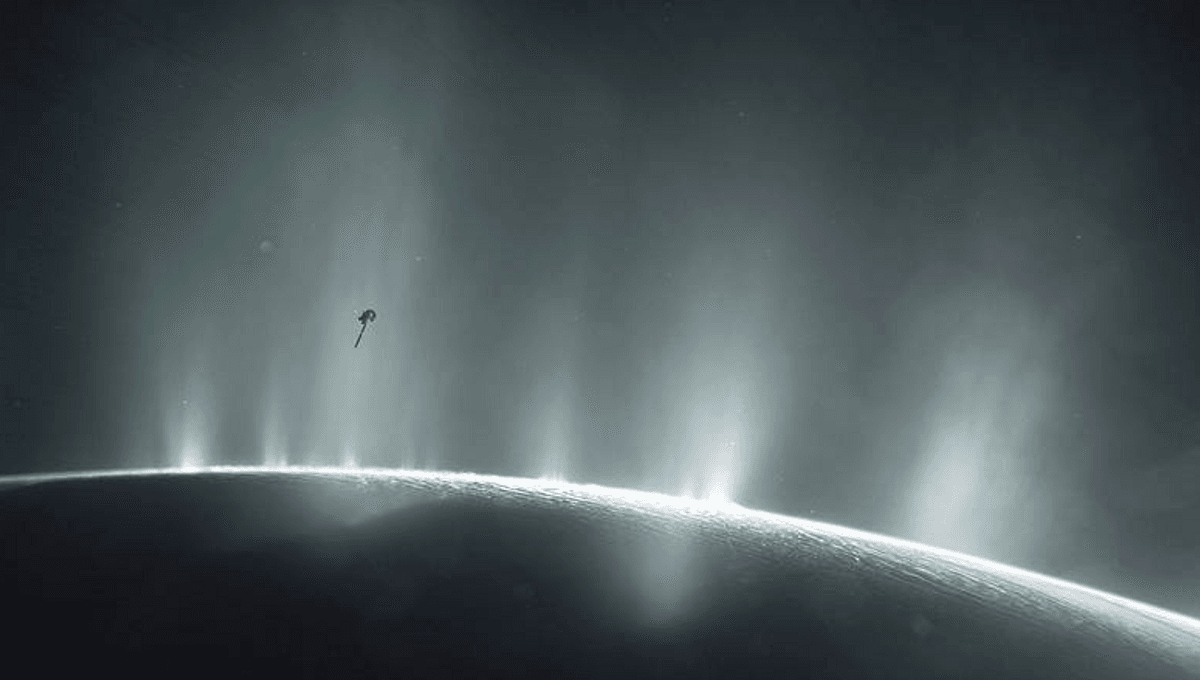
The JWST is hundreds of thousands of times further from Enceladus than the Cassini spacecraft once got, but that hasn’t stopped it from revealing things about the small but fascinating moon the probe missed. Indeed, scientists have revealed at a conference that Cassini failed to take in the full scale of Enceladus’s water plume, spotting the biggest one yet.
The discovery of geysers near the south pole of Saturn’s moon Enceladus rocketed the previously low-profile satellite to the top of planetary scientists’ priority list. Not only is Enceladus one of a half dozen (or perhaps dozen) bodies in the Solar System with oceans hidden beneath icy crust, but it frequently sprays portions of that ocean into space, with some of the particles ending up as part of Saturn’s E ring.
Combined with the discovery Enceladus has all the ingredients needed to support life – at least the ones we know of – this means a sample of the plumes is precious beyond words. It’s quite possible that evidence of biological activity could be contained in the plume, indicating the universe is awash with life.
Given the long time until a spacecraft will be ready to collect plume samples, every scrap of knowledge we can eke out is precious. When the JWST turned its focus in that direction recently, it produced more than a scrap, recording the size of an outburst. “It’s immense,” Nature reports Dr Sara Faggi of the Goddard Space Flight Center said at a conference last week.
Cassini first revealed the geyser’s existence in 2005. On subsequent fly-bys, the probe provided observations of the “tiger-stripes” near the moon’s south pole that enabled reconstructions of how material is getting from the internal ocean to the surface and beyond.
Since the geysers were unknown when Cassini was being built, it wasn’t designed to sample their spray. Nevertheless, it still managed to reveal the crucial presence of silica particles, which suggests the oceans are mixed well enough that material from the floors makes its way to the fractures from which these fountains erupt.
However, it can be hard to get a clear look at something you’re too close to, let alone inside, so Cassini wasn’t able to get a full sense of the plumes’ size. That’s where the JWST comes in. Using just 4.5 minutes of its precious time, the space telescope revealed a cloud much larger than any Cassini could spot, stretching much further into space than the diameter of the moon it comes from.
Dr Faggi isn’t giving away anything more, other saying to wait for the paper, which apparently will estimate the volume of water released and its temperature – something the JWST is particularly suited to estimating. Potentially more significantly still, JWST’s images could reveal something of the plume’s composition, potentially even including biosignatures. “We have many more surprises,” was all Faggi told Nature.
Although the size of the plume means a future mission could collect samples over a greater area, if we’re going to send a mission a billion kilometers to Saturn, we’ll probably want to swoop low to collect from where the material is densest. That’s if we don’t drop a robotic snake right into a crevasse. Long before that, however, JWST’s second round will see it spend six times longer observing Enceladus, suggesting JWST’s schedulers regard the first viewing as productive as Faggi is hinting.
Meanwhile, Nature reports the same conference also had big news from the original interior ocean world, with fellow Goddard scientist Dr Geronimo Villanueva reporting the discovery of carbon dioxide on Europa.
Source Link: JWST Reveals Plume From Enceladus’s Geysers Is Much Bigger Than We Knew